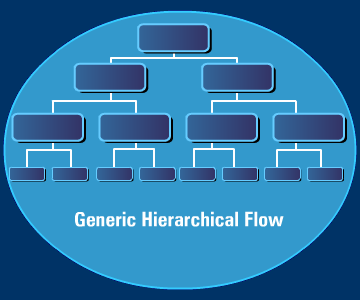With a glimpse in the rearview mirror – after a year of retirement from a long business career, including a couple of decades in middle management roles for an insurance company – clarity and objectivity are now closer than they appeared when I was in the job and balancing the interests of reporting staff with the management expectations of a large organization.
Clarity, because hindsight tends to cut through the hierarchical haze to highlight shortcomings living within it.
Objectivity, because there is fresh perspective and pleasant liberation in a viewpoint with no particular obligation to uphold a corporate position.
**************************
 Success is measured in many ways. Sales, growth and profitability are clear indicators for many operations. Perception, job satisfaction, and the commitment of the employee base is another important yardstick. Managing things to achieve success in the second area likely enhances the chances of sustained quantitative success in the first. Some corporations will exhibit evidence of long-term success with the business benchmarks and the perception of the people employed to achieve them. Others may be more tightly focused on results, with less of an appreciation for the human resources ultimately expected to bring them about.
Success is measured in many ways. Sales, growth and profitability are clear indicators for many operations. Perception, job satisfaction, and the commitment of the employee base is another important yardstick. Managing things to achieve success in the second area likely enhances the chances of sustained quantitative success in the first. Some corporations will exhibit evidence of long-term success with the business benchmarks and the perception of the people employed to achieve them. Others may be more tightly focused on results, with less of an appreciation for the human resources ultimately expected to bring them about.
It’s a balance that can change with the decision-makers and corporate strategies of the day. Mergers and acquisitions invariably introduce new people, ideas, and mandates. Even without major corporate transformation, the leaders will inevitably change. Business strategies and initiatives need to change if a company hopes to succeed in a competitive environment.
For large operations, results, ‘corporate’ cultures, and employee perception may vary by unit or region. Whether long-term with a single organization, or one who has been mobile, chances are employees will have encountered highly effective and inspiring managers and plans, and others, short-sighted and flawed.
Reflecting on variations, both inside and outside my own employment during 35 years in the financial services industry, I’ve come to better appreciate three points of opportunity in terms of employee perception, job satisfaction and commitment, in the world of the corporate hierarchy:
The best ideas and earliest warnings are found closest to the customer or product
Organizations are well served by meaningful initiatives to harvest and act on the ideas or concerns of those at the front line of the operation. These are the people in the organization who will know soonest, what is working and what is not.
 In an ideal world, these answers flow smoothly through the hierarchy. Immediate supervisors and managers facilitate regular discussions, formally and informally. They ask questions and listen carefully to the answers. When a matter exceeds local authority, capability, or is of broader interest, the diligent manager feeds it up the line where it is given careful consideration by the appropriate authority. As a consequence, changes are made to improve processes, products, or services, and originators of the ideas are recognized for their initiative.
In an ideal world, these answers flow smoothly through the hierarchy. Immediate supervisors and managers facilitate regular discussions, formally and informally. They ask questions and listen carefully to the answers. When a matter exceeds local authority, capability, or is of broader interest, the diligent manager feeds it up the line where it is given careful consideration by the appropriate authority. As a consequence, changes are made to improve processes, products, or services, and originators of the ideas are recognized for their initiative.
In the real world, supervisors and managers are busy people. Some are more effective than others, operationally, technically, and in managing people. The input from the front-line team member may manifest directly or indirectly. It may be communicated eloquently, thoroughly, and constructively, it may come in the form of a complaint to a colleague, or manager, it may be evident in an enduring, silent frustration, or it may emerge in the form of a changed attitude or performance pattern.
While managers may prefer the former, they should be alert and sensitive to the latter scenarios. Whether eloquent, suppressed, disguised, or raw, it usually starts with a genuine concern for bringing about improvement in the organization.
Some observations and pitfalls in a typical corporate hierarchy:
a) The more layers of management, the more muddled the messages flowing in both directions. Problems can get lost, or buried – rather than dealt with. Flatter organizations will have better odds for effective two-way communication, reaching the right interests, and effecting timely action as necessary.
b) The realization and repercussions of The Peter Principle is a near certainty in a bloated corporate hierarchy. The more layers of management, the more chance someone will reach their level of incompetence, between senior decision makers and the work. Middle management, as the name may suggest, manage in both directions. Some more effectively than others, some more deftly. It can take time to identify a misplaced manager in a hierarchical maze and the interim costs in employee morale and the business result can be profound.
c) It’s much easier to install an employee or manager than it is to remove or replace them. Few managers, at any level, could claim not to have made a placement mistake. If it’s beyond a training, rehabilitation, or reassignment issue, it’s better to deal with it quickly and mitigate the damage.
d) Front line staff discuss operational problems, ineffective colleagues, and unfit bosses, long before any senior manager ever hears about it. A prudent corporate practice includes a regular, direct, and risk-free process of employee feedback, evaluates responses carefully, and acts on them as necessary. But it has to be safe. There would be no more certain way to stifle feedback and quash morale than a ‘risk-free’ commitment that translates to direct or subtle consequences for the supplier.
Fair doesn’t have to be equal, it just needs to be fair
 There are assorted definitions and viewpoints for treating employees equally – particularly in the non-unionized work environment – versus treating them fairly. Whether a management or non-management employee, many accept that fair treatment is not necessarily equal treatment. Whether it’s salaries, bonuses, special projects, training opportunities, or other perks, the 20% of high performers will usually fare better than the 65% solid performers and certainly the 15% of others. From the perspective of any business, it is difficult to dispute that logic.
There are assorted definitions and viewpoints for treating employees equally – particularly in the non-unionized work environment – versus treating them fairly. Whether a management or non-management employee, many accept that fair treatment is not necessarily equal treatment. Whether it’s salaries, bonuses, special projects, training opportunities, or other perks, the 20% of high performers will usually fare better than the 65% solid performers and certainly the 15% of others. From the perspective of any business, it is difficult to dispute that logic.
The key word is fair. If the rewards go beyond fair reflection of performance and value an employee adds to an organization and crosses into the realm of favouritism, there is a serious morale problem brewing. With the exception of extreme and obvious cases, there is often a fine line between perceived and actual favouritism. While either case presents a problem, it may be only the direct manager – after objective consideration – who will know if that line has been crossed.
Divided views on the question of fairness will be a reality in virtually all meritorious work environments. The problem is likely not so much what the ‘stars’ get, as it is what the ‘grinders’ don’t get. There is no question that top performers should be compensated accordingly. Those above average, in value and results delivered, should be rewarded. They may well be the future leaders of the company. But what about the backbone members of the team? The 65% who may or may not aspire to higher positions, but make a crucial contribution with strong performances every day. Are they being compensated commensurately? Treated fairly?
 a) The one certainty about salary budgets is they will rarely be as generous as the managers who dispense them would like. Legitimate high performers need to get their share. Most employees appreciate the value this 20% of the team brings to the whole. But organizations should ensure a salary budget that fairly recognizes and reflects the value of the 65%.
a) The one certainty about salary budgets is they will rarely be as generous as the managers who dispense them would like. Legitimate high performers need to get their share. Most employees appreciate the value this 20% of the team brings to the whole. But organizations should ensure a salary budget that fairly recognizes and reflects the value of the 65%.
 b) Salary is not the only currency for recognition, of course. Whether specific acknowledgement of work done well, a special project, an opinion sought, a field trip, training opportunity, or a day off. Some companies have formal rewards programs that keeps employee recognition top-of-mind and actively dispensed at all levels of the company. Points are accumulated with a menu of offerings available at the various point levels. There are many ways to recognize and reward the good work and important contribution of those delivering it.
b) Salary is not the only currency for recognition, of course. Whether specific acknowledgement of work done well, a special project, an opinion sought, a field trip, training opportunity, or a day off. Some companies have formal rewards programs that keeps employee recognition top-of-mind and actively dispensed at all levels of the company. Points are accumulated with a menu of offerings available at the various point levels. There are many ways to recognize and reward the good work and important contribution of those delivering it.
What gets measured gets done. But does it get done right?
 Measurement is a fundamental component of most management by objectives (MBO) processes. Whether it’s from the teachings of Peter Drucker, Tom Peters, or others, you can be pretty sure that measurement follows some form of objective setting – collaborative or otherwise. At the very least, there should be communication of a clear set of production / performance standards against which employees understand they will be measured. There is nothing wrong with realistic and achievable stretch targets.
Measurement is a fundamental component of most management by objectives (MBO) processes. Whether it’s from the teachings of Peter Drucker, Tom Peters, or others, you can be pretty sure that measurement follows some form of objective setting – collaborative or otherwise. At the very least, there should be communication of a clear set of production / performance standards against which employees understand they will be measured. There is nothing wrong with realistic and achievable stretch targets.
A potential pitfall is when the measurement reflects a quantitative bias on the part of the organization, but fails to capture it’s qualitative expectation. Or put differently, the celebration and recognition of the employees’ total number of widgets produced, rather than the number that meet an acceptable standard of quality. Depending on the product or service, and the reliability of the front-end quality screen, the cost can be extensive: the time and money spent on the replacement or reissue, the dissatisfaction and lost confidence of the consumer, the productive impact on other staff drawn into the fix.
This distinction is as important for the service industry as it is in the manufacturing sector. If there is recognition and reward for sheer numbers, without regard for quality, that’s exactly what is reinforced in the frenzy to meet the quota. The employee who produces lower numbers of high quality work will be forced to: drop their quality standards to meet the numbers that earn the recognition; languish in the frustration of a counter-productive MBO; or move to find a better model elsewhere.
Productivity measurement is more effective meeting two tests.
a) It should be highly automated to remove the need for manual counts which either rely on an honour system or the efforts of others whose time could be better used to engage in the core duties of their own job.
b) It should be designed to reinforce not just the count, but the standard of quality expected in the work completed, products finished, or services delivered.
*************************
The starting point of all achievement is desire
– Napoleon Hill


Leave a Reply